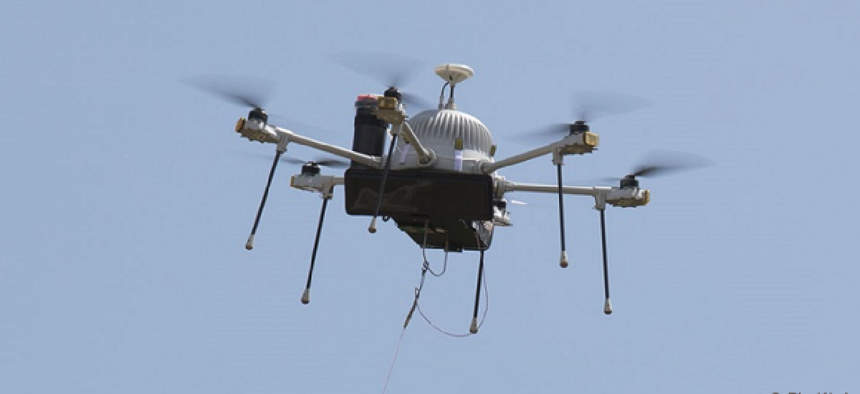A drone that can stay aloft all week


Connecting state and local government leaders
CyPhy Works' tethered drone can hover 400 feet above the ground for extended surveillance, disaster response and other missions.
Agencies have come to rely on drones for bridge inspections and search and rescue operations. One of their major drawbacks, however, is the length of time unmanned systems can stay airborne without being recharged.
The Persistent Aerial Reconnaissance and Communications (PARC) drone from CyPhy Works, however, can climb to 400 feet and stay there for up to a week. Because it is tethered to the ground, it can’t range far from base.
“Many of the drones are meant to go out and see things at a distance,” CyPhy Works founder and CTO Helen Greiner said. “What we’ve done is we built a drone, and it goes up and gets you that persistent image or communication network or any kind of sensor reading that you need.”
The drone is currently being used for surveillance by the military and the Boston Police Department. Sprint also tested it earlier this month as part of an aerial small-cell network.
The drone can pull its power from whatever ground-based source is available, whether a generator or an electrical outlet. In the future the company may power the PARC drones with a vehicle with a “hefty alternator,” Greiner said. CyPhy Works also has its own cloud service that gives users access to live video feeds from the drone, archived video and even the performance metrics of the system.
Power and data are both carried over the same microfilament cable, a technique that the company has patented. “We superimposed the data on the power line, which makes it very light,” Greiner said.
Two CyPhy Works tethered drones conducted surveillance for the 2017 Boston Marathon, providing live video feeds of the Athletes' Village and the starting line in Hopkinton, Mass., to the Emergency Operations Center, the Multi-Agency Coordination Center and the Race Operations Center, according to a report by the Massachusetts Emergency Management Agency.
The company also teamed up with the American Red Cross and UPS Foundation on a pilot to use drones to assess damage after natural disasters. The PARC drones carrying 30X zoom cameras were deployed after Hurricane Harvey to assess damage from and give responders "a stable fixed-location point of observation to help capture these crucial images without interruption,” company CEO Lance Vanden Brook said.
Sprint has been using the drone to carry its Sprint Magic Box aerial small-cell solution as a way to expand its 2.5 GHz data service up to 10 square miles. Besides enabling more coverage and capacity to support temporary spikes in network traffic at large events, venues or public gatherings, the solution can be used in emergency response, flying data services into hard-to-reach locations following natural disasters, the company said.
Researchers at the University of North Texas also are exploring the use of drones to carry portable cellular base stations so that they can be flown to areas where cell service is lacking. Rather than use a tethered drone, however, these efforts are working to reduce the weight of the base station to maximize flight time.
CyPhy Works is also looking at the possibility of using artificial intelligence to autonomously monitor the surveillance feeds. The system would learn what's normal and send alerts when it spots abnormal behavior, Greiner said.
“We look at it in the future as a base for an artificial intelligence system that monitors and manages a facility,” she said.




